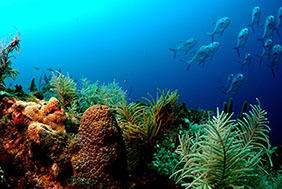-
Home
-
Data & Publications
-
Regional Portals
- About Regional Portals
- Florida
- Navassa Island
- Puerto Rico
- Flower Garden Banks
- U.S. Virgin Islands
- American Samoa
- Commonwealth of the Northern Mariana Islands
- Federated States of Micronesia
- Guam
- Main Hawaiian Islands
- Republic of the Marshall Islands
- Northwestern Hawaiian Islands
- Republic of Palau
- Pacific Remote Island Areas
-
CRCP Activities
- Glossary
Recovery Plan for Elkhorn Coral (Acropora palmata) and Staghorn Coral (A. cervicornis)

Elkhorn (Acropora palmata) and staghorn (A. cervicornis) corals were listed as threatened under the U.S. Endangered Species Act (ESA) on May 9, 2006. Elkhorn and staghorn corals were once the most abundant and important species on Atlantic/Caribbean coral reefs in terms of building reef structure. Both elkhorn and staghorn corals underwent precipitous declines in abundance throughout their ranges in the 1970s and 1980s. Although quantitative data on former distribution and abundance of these species are scarce, in the few locations where quantitative data are available (e.g., Florida Keys, Dry Tortugas, Jamaica, and the U.S. Virgin Islands), declines in abundance are estimated at greater than 97 percent. The threats to these species that are impeding recovery are: disease, increasing temperature, depensatory population effects, loss of recruitment habitat, sedimentation, anthropogenic abrasion and breakage, predation, inadequacy of existing regulatory mechanisms, natural abrasion and breakage, ocean acidification, and nutrients and contaminants.
The purpose of this recovery plan is to identify a strategy for rebuilding and assuring the long-term viability of elkhorn coral and staghorn coral populations in the wild. The goal, objectives, and criteria represent our expectation of what is needed to increase the abundance and to protect the genetic diversity of elkhorn and staghorn coral populations throughout their geographical ranges and ultimately to remove these two coral species from the list of endangered and threatened species. Recovery criteria can be viewed as targets, or values, by which progress toward achievement of recovery objectives can be measured.
In this report, the Population-based Recovery Criteria (criteria 1-3) represent what recovered species would look like. The Threat-based Recovery Criteria (criteria 4-10) represent the conditions needed to abate the impacts of threats identified as contributing to the species’ threatened status and allow them to sustain a recovered status.
Recovery under the ESA is an iterative process with periodic required analyses to provide feedback into species’ listing status and progress toward recovery. The ESA requires a review of the status of each listed species at least once every five years after it is listed. Periodic review of the species may lead to updates or revisions of the recovery plan, changes in the listing status of the species, or delisting. While meeting all of the recovery criteria would indicate that the species should be delisted, it is possible that delisting could occur without meeting all of the recovery criteria if the best available information indicated that the species no longer met the definition of endangered or threatened. In the case of elkhorn and staghorn corals, it is possible that because of the interaction between the threats and the species’ population responses, fully achieving all of the Threat-based Recovery Criteria may not be necessary to achieving restored, sustainable populations if the benefits to the species from successfully addressing one threat (e.g., nutrient enrichment) make them more highly resilient to another threat (e.g., disease). Changes to the species’ status and delisting would be made through additional rulemaking after considering the same five ESA factors considered in listing decisions, taking new information into account.
Citation: National Marine Fisheries Service. March 2015. Recovery Plan for Elkhorn (Acropora palmata) and Staghorn (A. cervicornis) Corals. Prepared by the Acropora Recovery Team for the National Marine Fisheries Service, Silver Spring, MD. 167 p.
Recovery Plan for Elkhorn (Acropora palmata) and Staghorn (A. cervicornis) Corals
For more information contact:
Alison Moulding
(727) 824-5312
Alison.moulding@noaa.gov


